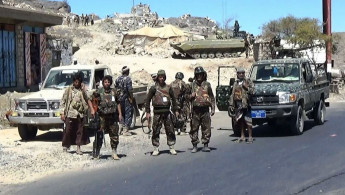When two tribes go to war in Yemen
Preparations for armed struggle are under way among the tribes of southern Yemen. Men in the mountains around al-Bayda are getting their rifles ready and digging in, brazing for a Houthi assault, as the Zaydi fighters slowly make their way south to the Yafa region.
Jabal al-Arr is the highest mountain in Yafa. To the east is Bayda, which is considered part of the north, and to the west is Lahj, which is seen as southern.
Symbol of the south
Although every inch of the rocky Yafa district is important, Jabal al-Arr has particular significance to local tribes. When reports came in that Houthis were heading south to the mountain, armed tribesmen flocked to Jabal al-Arr to defend the territory. Since October, there has been sporadic but heavy fighting between the Houthis and local tribes for control of Bayda.
It is not just the Houthis who have their eyes on this mountain. The Republican Guard, whose members remain loyal to the former president Ali Abdullah Saleh, have for years tried to recapture Jabel al-Arr.
The Republican Guard had a regiment based here until 2011, when a local uprising forced the elite soldiers to retreat to the north.
Yafa is staunchly "southern" in its outlook, and has enjoyed a degree of autonomy since the army was repelled here in 2011. Tribesmen in Yafa are among the fiercest and proudest in Yemen, and the separatist Southern Movement enjoys huge grassroots support here.
Locals describe Jabal al-Arr as being the first place in the south to be "liberated" from the north, and every year, locals celebrate the "liberation" of the mountain.
Part of the reason that Jabal al-Arr is such a hotly contested territory is that it acts as a main artery between Yafa and the "northern" city of Bayda. The city centre is just 25km away and there have been ongoing clashes between the tribes and Houthis in al-Zaher, which separates Jabal al-Arr from Bayda, since October 2014.
| Locals describe Jabal al-Arr as being the first place in the south to be "liberated" from the north. |
Houthi advance
After the Zaydi insurgents took control of Bayda, thousands of tribesmen around Jabal al-Arr picked up their Kalashnikovs and headed to Bayda to halt the Houthi juggernaut.
"Yafa is well protected by the mountains surrounding it from all sides. Its tribal community helps protect it against any external aggression," says Fawaz al-Hanashi, a journalist who is from the area.
"After the 1994 war between the north and the south, the army established a base on Jabal al-Arr, on the border with Bayda. The people of Yafa could not tolerate this."
In April 2011, the tribes launched a successful assault on the Republican Guard base at the foot of the mountain, and expelled the soldiers in May 2011, seizing their weapons and equipment.
Hanashi said the people of Yafa are now ready to repel any new attacks launched by the Houthis and the national army.
He says that there are reports about the army is preparing to retake the base on the mountain, and the Houthis are massing on the border of Yafa.
New assault
The area's location gives it its strategic importance, said Abdul-Aziz al-Mansouri, head of the Southern Movement of Laboos in Yafa.
"The military significance of Jabal al-Arr has to do with the fact that it overlooks vast open areas of Yafa and Bayda, and whoever controls it can control and target many other important positions."
"This mountain is a symbol, and its name has been linked to the history of the longstanding southern tribe Yafa tribe."
With the Houthis on the doorstep, the situation today has echoes of the past. In 1645, a former northern Zaydi ruler, Imam Ahmad ibn al-Hassan, was able to control the south after he took Jabal al-Arr and other parts of Yafa.
His control of the region lasted for 20 years, until the local tribes rose up and pushed the Imam's forces back to the north, liberating the whole region.
"To pre-empt the coming threat from the Houthis, political and tribal forces in Yafa that are led by the Southern Movement, tribal elders, and the local authorities have closed ranks to prevent any armed groups from reaching Yafa, [or the army]," Mansouri says.
Jabal al-Arr thus looks set to be the site of a modern day battle between the Yafa tribes, and the Houthi-Republican Guard fighters. The army unit still bears a grudge against the tribes that forced it to retreat from the mountain.
The Houthis, meanwhile, will want to control Yafa and Jabal al-Arr as it is the gateway to the south, and then the whole of Yemen will be under its tutelage.
This article is an edited translation from our Arabic edition.



